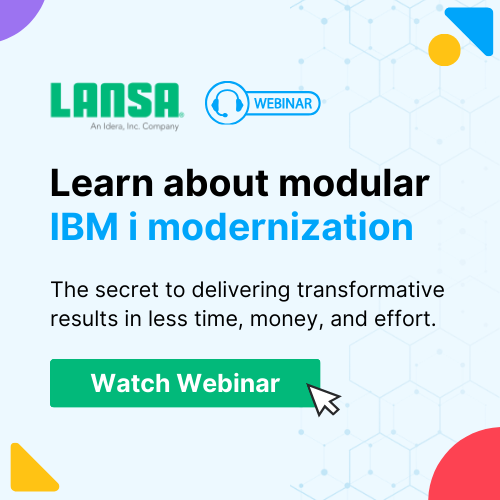IBM i Application Modernization is a long-term project that requires a holistic assessment of your business operations. It’s not a journey you can take before you know exactly where you want to go. So, before you get started, you need a strategy that guides you toward your long-term business goals.
Unfortunately, there’s no one size fits all modernization strategy. That means no predefined framework or best practices similar to the Information Technology Infrastructure Library. (ITIL). The good news, however, is that the right strategy is the one specific to your business. It takes your resources, application portfolio, and short and long-term business goals into account.
This article provides step-by-step guidance for modernizing with .NET. It should help you formulate your application modernization strategies.
How Can You Assess Application Portfolio for Modernization?
Many organizations run multiple applications. In fact, the longer an enterprise is in business, the larger and more diversified its application portfolio is likely to be. This article assumes you’re running both IBM i and Windows applications or you’re looking to integrate. Regardless, a thorough assessment of your application portfolio is the essential first step for every modernization strategy. This involves taking inventory of all your existing applications and rating each application’s role in achieving your short and long-term goals.
There are two critical factors for rating your IBM i applications for modernization — business value and whether or not they are mission-critical. The business value of an application lies in its importance to your bottom line. Once you’ve rated your applications using these factors, categorize them into four groups: Retire, Tolerate, Modernize, and Invest.
Retire applications qualify for elimination. They are redundant applications or applications with no significant business value. In other words, their operation and maintenance costs far outweigh their benefits.
Tolerate includes applications that provide business value but aren’t embedded in the company infrastructure. They also require light support.
Invest in applications that show a high potential to deliver good business value but require reengineering or other major infrastructural enhancement.
Last but not least, the modernize category refers to applications with high business value but are a poor technology fit. Everything in this category significantly affects the bottom line. Unfortunately, they also rely on unsupported hardware, platforms, or a dwindling human resources pool. This is the most important category in the context of this article. They represent modernization opportunities — build your modernization strategy around them.
What Modernization Techniques Should You Implement?
Choosing modernization techniques for applications that fall under the modernize category can be overwhelming especially considering the variety of options. You need a strategy that helps you achieve your short and long-term goals.
A proven approach for integrating IBM i with Windows applications is adding a graphical user interface or web-enabling IBM i applications. You can then provide .NET access to IBM i data.
Learn more about the different techniques you can use in this article on IBM i AS400 application modernization.
How Can You Web-enable IBM i Applications?
.NET applications run on graphical user interfaces. Because of this, you need to modernize your 5250 green screens. LANSA aXes is a unique solution that converts 5250 applications to graphical web interfaces on the fly. You don’t need programming skills, and you certainly don’t need access to the source code. You simply install aXes on IBM i, and your employees get secure access to their 5250 applications from any web-enabled device like laptops, phones, and tablets.
Best of all, your end-users don’t need to install anything on their devices. IBM i does all the work. aXes is a simple but powerful solution that accelerates your IBM i digital transformation.
Another benefit of leveraging aXes is the luxury of scaling. If you need to add mobile capabilities to your IBM i applications, start there and add other functions as time allows.
Learn how your organization can benefit from the comprehensive IBM Mobile App Development experience with LANSA.
How do You Grant .NET Access to IBM i Resources?
To access your IBM i resources from the graphical user interface of your .NET applications, you need IBM i middleware. LANSA Open for .NET is powerful middleware. It is a Visual Studio plugin that gives Windows developers access to IBM i (AS/400, iSeries) resources directly within their .NET applications. This includes data and programs. LANSA Open offers easy integration between the platforms.
LANSA Open lets IT departments safely open up their IBM i data and applications to various internal and external .NET applications. With Open, you can do this without risking security or data integrity. The result is a better user experience for your customers and employees. Other benefits of this solution include, but are not limited to the following:
Is there .NET and IBM i Collaboration?
LANSA open also allows you to break down application silos and achieve a single version of the truth. It allows .NET and IBM i to share real-time data, automate business processes, and eliminate synchronization between platforms.
Can I Control Access to IBM i Data from .NET?
With LANSA Open for .NET, IT departments can also open up enterprise data to internal and external applications without risking security or data integrity. This is because LANSA’s Business Rules Engine enforces validation logic and ensures that unacceptable data never hits the database.
Is there Faster Transfer of Data and Information?
Next, LANSA Open for .NET implements native record-level access to Db2 data over an encrypted, secure connection. Using native record-level access also means .NET applications can quickly work with large volumes of Db2 data by taking advantage of IBM i’s powerful data processing capabilities.
Is There Tighter IBM i Security from .NET?
Because LANSA Open for .NET’s runtime DLL encrypts and compresses data during transmission between the client and the server, it protects sensitive data from being compromised as it is sent down the wire. LANSA Open uses industry-standard DES or Twofish encryption.
Is There Easier Resource Management of Dev Teams?
Finally, LANSA Open reduces the challenges of managing siloed development teams and multi-platform projects. With open, you can share resources between mixed .NET, RPG, and COBOL development environments by reusing the same enterprise business logic, validation rules, and calculations.
Are You Ready to Build Your .NET Modernization Strategy?
This article claims assessing your application portfolio is the first step to any modernization strategy. It also emphasizes the importance of knowing where you want to arrive before taking the first step. This involves defining your short and long-term business goals and objectives. Do you want to modernize one legacy application module or the whole application? Are you looking to leverage your existing developer skills? Whatever your goals, following these steps will help you develop a business-specific modernization strategy.
Ultimately, if your goal is to integrate IBM i applications with .NET applications, modernizing your user interface with aXes and then connecting your modernized apps to .NET applications using LANSA’s Open for .NET will help you get there.
Contact us for your information on IBM i application modernization.










